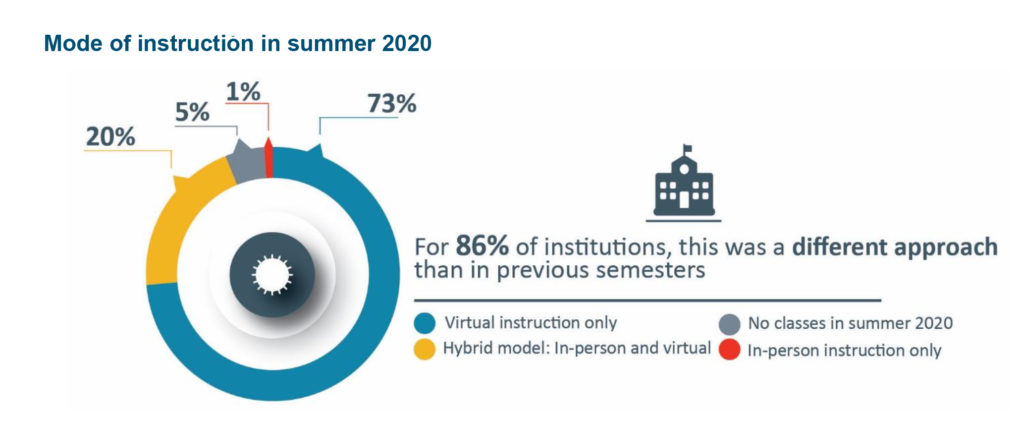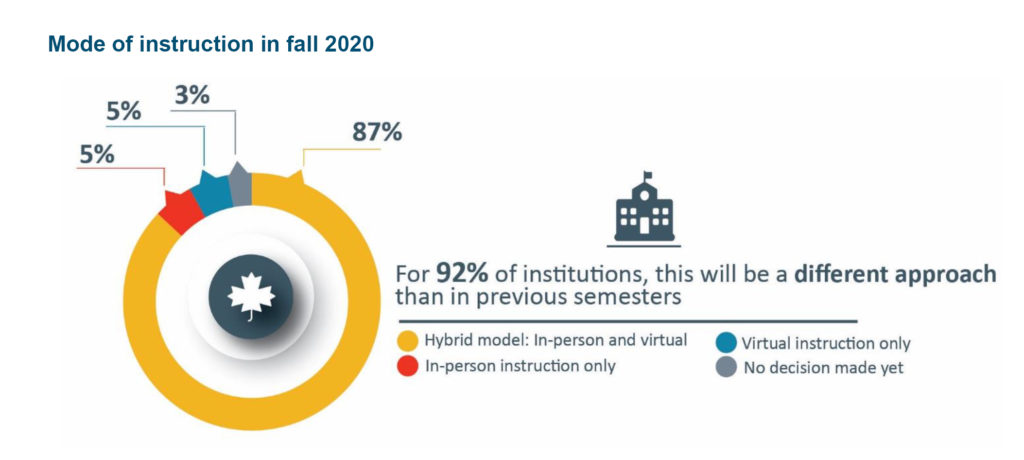The novel coronavirus has affected all aspects of society and the economy. But what do the data say about the impact of the pandemic on community colleges?
Getting timely and reliable data on two-year colleges is challenging. Many of the key metrics are not systematically collected nor reported nationally. This article will look at some of the available data to get a sense of the effects of Covid-19 on this sector of higher education.
Spring effects
One of the first impacts of the coronavirus crisis was moving community colleges’ course delivery from in-person to almost exclusively online. In fall 2018, only 14 percent of all community college students studied exclusively online, and slightly more than one-third (35 percent) took some classes online. State-level data are available in this DataPoints.
These data highlight the heavy-lift among colleges this spring in shifting from in-person to near-exclusive online delivery, and the concern that a significant number of students would not finish the term because of other challenges due to the pandemic, such as job security, personal safety and childcare, among others.
Data from the National Student Clearinghouse (NSC) Research Center looked at spring inter-term losses across the most recent three years. As shown above, these data suggest that across all sectors, student loss within the spring term was nearly the same in this spring as it was in spring 2018 and 2019. Digging a bit deeper into the data did reveal that there were more people taking a leave of absence later in the term, compared to prior years, and some suggestion that there were differences by race/ethnicity.
Financial impact
The American Association of Community Colleges (AACC) collected data on the early financial impacts of the pandemic. More than half (54 percent) of colleges reported changes in state and local appropriations would significantly affect their budgets, while approximately one-third said their budgets would take a big hit due to changes in revenues from tuition and fees, auxiliary enterprises and noncredit activities resulting for the pandemic. The cost of technology was the most frequently cited expense related to COVID.
As noted above, community colleges were projecting that cuts to state and local appropriations would significantly impact their budgets. To help alleviate some of the financial pressures, Congress passed the CARES Act, which provided substantial funds to higher education institutions. The funds were designated to be equally shared for students and institutions.
The maximum amount of CARES funds for community colleges represented about 5.1 percent of their 2017-18 total revenues, while the institutional portion was about 2.6 percent of those revenues. To put this into perspective, over half of the colleges in the AACC CEO survey indicated that they would experience revenue decreases of 10 percent or more — 70 percent of the colleges indicated they were above 5 percent decreases in revenues.
Summer enrollment
Just-released data from the NSC Research Center show significant enrollment declines this summer, compared to last summer, for community colleges and for-profit four-year colleges, while public and private, not-for-profit four-year colleges had increased enrollment this summer.
These data indicate that community college enrollment was down by over 5 percent this summer — and enrollment was even lower for Black and White students. The decreases were not consistent, as male enrollment declines are significantly higher than for women, full-time enrollment actually increased while part-time enrollment declined, and enrollment by students younger than 18 (a proxy for dual-enrolled high school students) was the only age group that showed increases in enrollment. The graphics below illustrate some of the changes.
Fall delivery
Colleges scrambled to move classes to an exclusive (or nearly exclusive) remote modality when the coronavirus first flared up in the U.S. Throughout the summer, higher education institutions have struggled with how to deliver classes during the summer and fall terms. The Institute for International Education (IIE) has conducted a series of surveys, and one of the items it has tracked is how colleges are or plan to offer courses. The data are for all of higher education, not just community colleges, but are illustrative (see below).

As seen in the figure above, very few (1 percent) of the responding colleges had exclusive in-person instruction, and most (86 percent) were offering instruction in a modality different than in prior semesters. When asked about fall 2020, only 5 percent expected in-person instruction and 3 percent virtual only, with most (87 percent) opting for a hybrid model.

The data above represented the colleges’ perspectives as of July 24, 2020, but recent events prove the saying that no plan ever survives contact with the enemy, as several higher education institutions (such as the University of North Carolina, Chapel Hill), opened with in-person classes and had to revert to remote learning.
Community colleges offer a significant number of career and technical education (CTE) programs that do not lend themselves well to remote learning, requiring hands-on learning. As a result, community colleges are striving to find ways to offer a safe environment for students to acquire the skills they need to be successful in the workplace.
Fall 2020 enrollment
Enrollment is one of the key drivers of revenue for community colleges. First, most community colleges receive revenue directly from tuition and fees; and second, many state appropriations are based on a formula that uses enrollment as a primary part of the appropriations calculation. Therefore, declines in enrollment directly and indirectly impact community college budgets.
The American Council of Education (ACE) has conducted a series of surveys of college presidents since the pandemic hit. The data above highlight the changing perspective on fall enrollment projections. In community colleges, original pessimistic enrolment projections in May improved somewhat in June, and then dramatically declined in July, concomitant with the rise in COVID cases. Community college enrollments have been declining since they peaked in fall 2010. However, early reports from community colleges suggest that enrollments this fall will be significantly lower than last year.
What it means
It is too early to fully assess the impact of the pandemic on community colleges, and we may not have the data to accurately assess the extent of the impact for many years. However, early evidence suggests that this fall will be unlike any in recent years, and college leaders are struggling with an ever-changing landscape to try and meet the educational needs of their students and communities.

